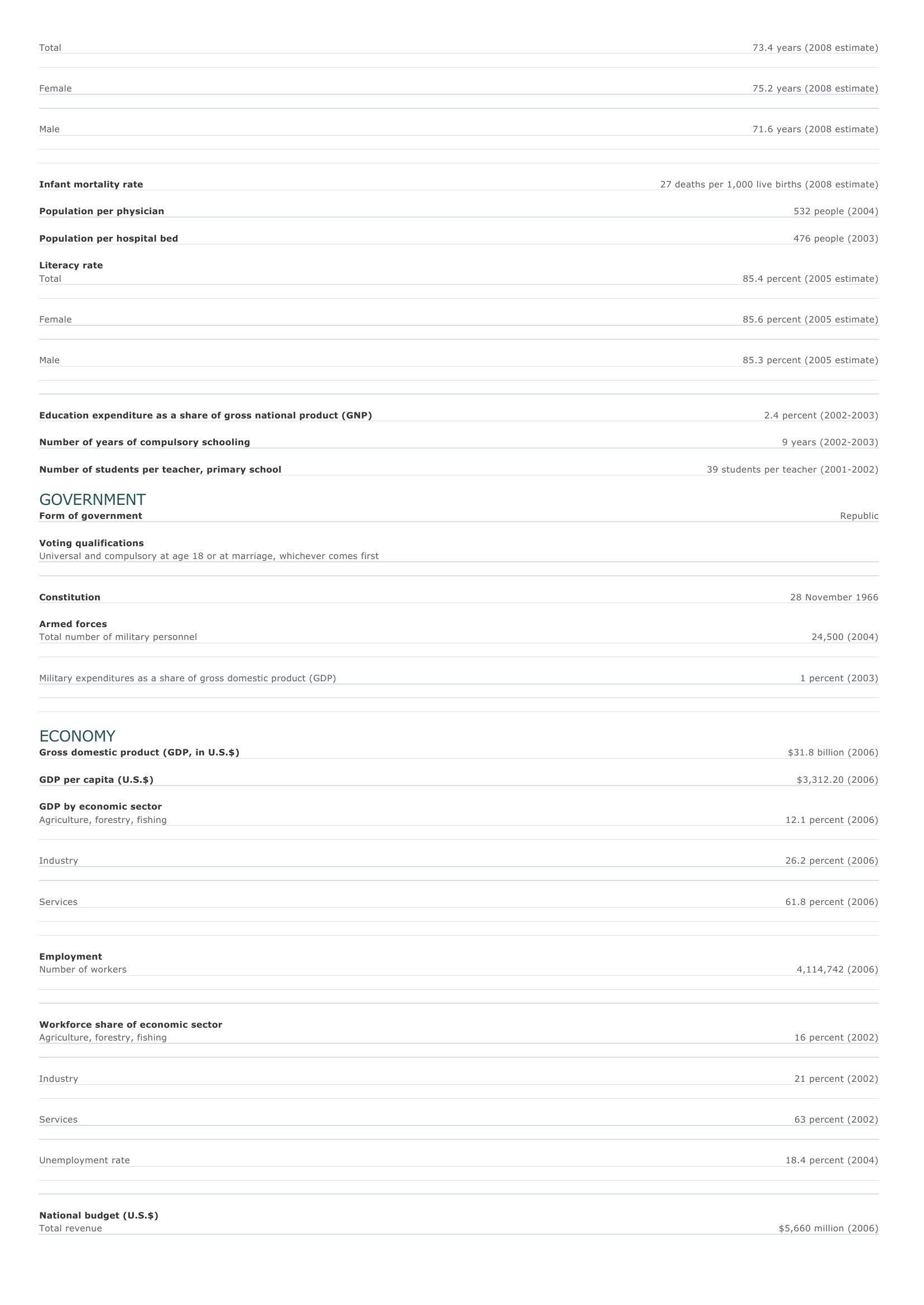Dominican Republic Facts and Figures. BASIC FACTS Official name Capital Area Dominican Republic Santo Domingo 48,400 sq km 18,700 sq mi PEOPLE Population 9,507,133 (2008 estimate) Population growth Population growth rate 1.50 percent (2008 estimate) Projected population in 2025 11,922,144 (2025 estimate) Projected population in 2050 14,657,962 (2050 estimate) Population density 197 persons per sq km (2008 estimate) 509 persons per sq mi (2008 estimate) Urban/rural distribution Share urban 60 percent (2005 estimate) Share rural 40 percent (2005 estimate) Largest cities, with population Santo Domingo 2,302,759 (2006 estimate) Santiago 908,250 (2006) San Pedro de Macorís 217,141 (2002) La Vega 220,279 (2002) San Francisco de Macorís 156,267 (2002) Ethnic groups Mixed 73 percent White 16 percent Black 11 percent Languages Spanish (official), French creole, English Religious affiliations Roman Catholic 89 percent Protestant 4 percent Indigenous beliefs 2 percent O ther 5 percent HEALTH AND EDUCATION Life expectancy Total 73.4 years (2008 estimate) Female 75.2 years (2008 estimate) Male 71.6 years (2008 estimate) Infant mortality rate 27 deaths per 1,000 live births (2008 estimate) Population per physician 532 people (2004) Population per hospital bed 476 people (2003) Literacy rate Total 85.4 percent (2005 estimate) Female 85.6 percent (2005 estimate) Male 85.3 percent (2005 estimate) Education expenditure as a share of gross national product (GNP) Number of years of compulsory schooling Number of students per teacher, primary school 2.4 percent (2002-2003) 9 years (2002-2003) 39 students per teacher (2001-2002) GOVERNMENT Form of government Republic Voting qualifications Universal and compulsory at age 18 or at marriage, whichever comes first Constitution Armed forces Total number of military personnel Military expenditures as a share of gross domestic product (GDP) 28 November 1966 24,500 (2004) 1 percent (2003) ECONOMY Gross domestic product (GDP, in U.S.$) GDP per capita (U.S.$) $31.8 billion (2006) $3,312.20 (2006) GDP by economic sector Agriculture, forestry, fishing 12.1 percent (2006) I ndustry 26.2 percent (2006) Services 61.8 percent (2006) Employment Number of workers 4,114,742 (2006) Workforce share of economic sector Agriculture, forestry, fishing 16 percent (2002) I ndustry 21 percent (2002) Services 63 percent (2002) Unemployment rate 18.4 percent (2004) National budget (U.S.$) Total revenue $5,660 million (2006) Total expenditure $5,207 million (2006) Monetary unit 1 Dominican peso (RD$), consisting of 100 centavos Major trade partners for exports United States, Netherlands, Belgium, France, and Haiti Major trade partners for imports United States, Venezuela, Mexico, Japan, and Spain ENERGY, COMMUNICATIONS, AND TRANSPORTATION Electricity production Electricity from thermal sources Electricity from hydroelectric sources Electricity from nuclear sources Electricity from geothermal, solar, and wind sources 89 percent (2003 estimate) 10.68 percent (2003 estimate) 0 percent (2003 estimate) 0.32 percent (2003 estimate) Number of radios per 1,000 people 178 (1997) Number of telephones per 1,000 people 101 (2005) Number of televisions per 1,000 people 99 (1998 estimate) Number of Internet hosts per 10,000 people 82 (2003) Daily newspaper circulation per 1,000 people 27 (2000) Number of motor vehicles per 1,000 people 47 (1997) Paved road as a share of total roads 49 percent (1999) SOURCES Basic Facts and People sections Area data are from the statistical bureaus of individual countries. Population, population growth rate, and population projections are from the United States Census Bureau, International Programs Center, International Data Base (IDB) (www.census.gov). Urban and rural population data are from the Food and Agriculture Organization (FAO) of the United Nations (UN), FAOSTAT database (www.fao.org). Largest cities population data and political divisions data are from the statistical bureaus of individual countries. Ethnic divisions and religion data are largely from the latest Central Intelligence Agency (CIA) World Factbook and from various country censuses and reports. Language data are largely from the Ethnologue, Languages of the World, Summer Institute of Linguistics International (www.sil.org). Health and Education section Life expectancy and infant mortality data are from the United States Census Bureau, International Programs Center, International database (IDB) (www.census.gov). Population per physician and population per hospital bed data are from the World Health Organization (WHO) (www.who.int). Education data are from the United Nations Educational, Scientific and Cultural Organization (UNESCO) database (www.unesco.org). Government section Government, independence, legislature, constitution, highest court, and voting qualifications data are largely from various government Web sites, the latest Europa World Yearbook, and the latest Central Intelligence Agency (CIA) World Factbook. The armed forces data is from Military Balance. Economy section Gross domestic product (GDP), GDP per capita, GDP by economic sectors, employment, and national budget data are from the World Bank database (www.worldbank.org). Monetary unit, agriculture, mining, manufacturing, exports, imports, and major trade partner information is from the statistical bureaus of individual countries, latest Europa World Yearbook, and various United Nations and International Monetary Fund (IMF) publications. Energy, Communication, and Transportation section Electricity information is from the Energy Information Administration (EIA) database (www.eia.doe.gov). Radio, telephone, television, and newspaper information is from the United Nations Educational, Scientific and Cultural Organization (UNESCO) database (www.unesco.org). Internet hosts, motor vehicles, and road data are from the World Bank database (www.worldbank.org). Note Figures may not total 100 percent due to rounding. Microsoft ® Encarta ® 2009. © 1993-2008 Microsoft Corporation. All rights reserved.





